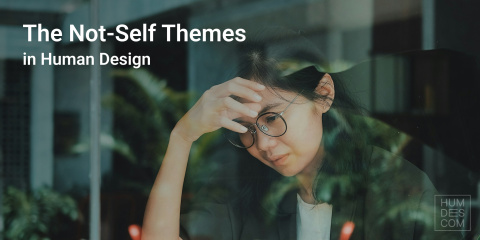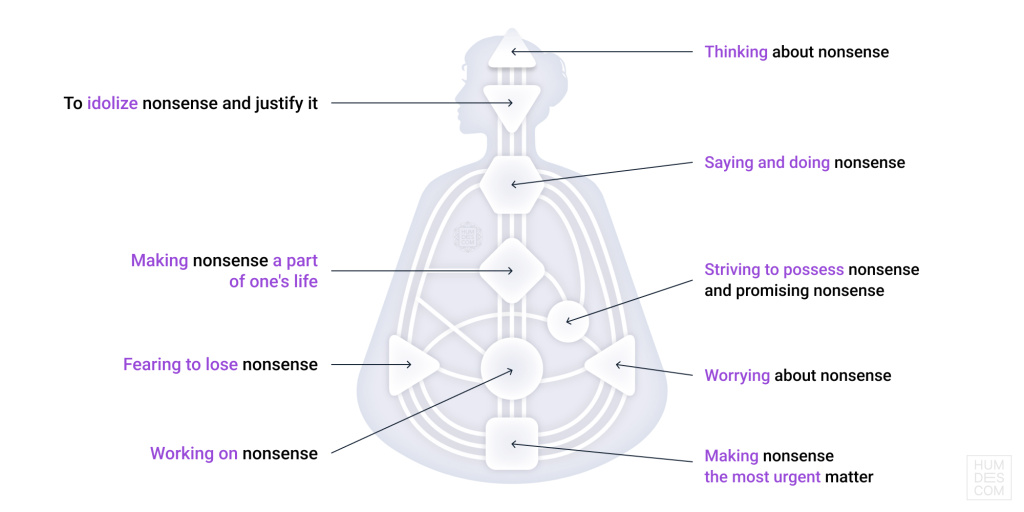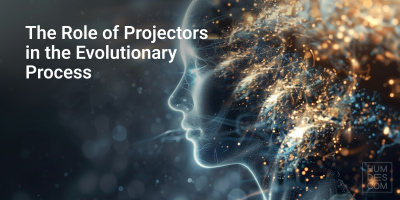The Not-Self Themes in Human Design

Introduction
Every individual is born with a built-in "navigation system" consisting of Strategy and Inner Authority. We can live our lives correctly if we abide by them. However, there are challenges on this path, and they come through our Not-Self.
What is the Not-Self in Human Design? Something good or, on the contrary, very bad? Is it worth trusting? And, most importantly, can and should it be gotten rid of somehow? We will go over this in the article.
What is the Not-Self in Human Design
One of the first topics that we come across when studying the fundamentals of Human Design is the Not-Self theme.
The true self is a concept that refers to our true reflection in the "mirror of life". On the other hand, there is the Not-Self - an image to which we can unconsciously conform; a system of values, convictions, and beliefs by which we can live.
In Human Design, the Not-Self themes represent the illusions we live with and the rules we follow that lead us astray. Our minds determine the laws of the Not-Self. We are thinking creatures, and that is where the main trap lies. It is the mind that carefully deceives us, attempting to take us away from our true selves and transform us into someone else who we are not. It tries to pass off someone else's "reflection" as our own, as if we had no idea what we really looked like.

The Not-Self in Human Design is a puzzle that our mind pieces together in an attempt to become the ultimate and unquestionable authority. What does it need it for? Everything is simple - this is the only way to maintain control over a person and their entire life.
Over time, the Not-Self becomes a nearly indestructible belief that consumes a tremendous amount of energy. This is not surprising given the amount of effort required to artificially maintain "stability" and "correctness".
Origins of the Not-Self
Strategy and Authority are the two pillars that assist a person in finding the answer to any question, making the correct decision, and generally following their own path. However, they require unconditional trust, and most people do not know how to trust themselves. Many of us simply do not hear ourselves, so we rely on other people or imposed attitudes, unconsciously entrusting our lives to them, and as a result, we experience bitterness, disappointment, frustration and other Not-Self themes.
When does it occur for the first time?
The primary source of frustration as a Not-Self theme in Human Design (or other themes) is conditioning. It begins in childhood, when parents take an incorrect approach to raising their children and do not consider their individual characteristics.

It is important to note that you should not blame your parents for this, as most of them only want the best for their child. The issue is that their perceptions of what would be best and what is actually best for the child are frequently diametrically opposed.
A real-life example:
John is the family's dearly loved and long-awaited child. His Rave Chart contains many individual activations, which is why he prefers to do things his way rather than being told. However, John's parents are unaware of this, so they are likely to be concerned that their child does not want to "play like everyone else" or "has no friends," and will do everything in their power to fit the child into society, despite the fact that he was not designed to do so.
However, a person grows accustomed to any situation, and John will do the same, but only to the Not-Self theme, or rather to the fact that "there is something wrong about him" and that he should try to be like the other children. He will be under constant pressure until he accepts such behaviour as necessary for his survival.
As a result, John will mature into an adult who has completely lost contact with himself and has no idea who he is, what he wants, or how to obtain it. And even if he believes he knows, it could just be the mind's tricks trying to control everything.
Conditioning is not limited to parents alone. We are influenced by everyone we come into contact with, including friends, teachers, and politicians. The second source of Not-Self theme formation is society, which has established norms, rules, and ideas about what constitutes a successful, realised, and happy person. But is it always possible to implement these templates while making everyone feel good?
How do other people affect us mechanically?
Take a look at your Rave Chart and the nine Energy Centres it contains. Those that are defined (coloured in) are the true you, this is what is given to you from birth. Everything else about the operation of undefined and fully open Centres (not coloured in) is not you. The operation of these Centres has a direct impact on the formation of frustration, disappointment, bitterness as the Not-Self theme, among other manifestations.
In general, any open spots in the Rave Chart are those with which we read the information and energy of others and in which we are susceptible to conditioning, and thus to the Not-Self formation. Let us look further into the Not-Self strategies in undefined and open Centres.
The “Not-Self” Strategies in Undefined Centres
The Not-Self in Human Design connects to our undefined and open Centres using the mind in order to feed us ideas, images, and thoughts when making a decision. The purpose of this is to force us to follow its own agenda, which has nothing to do with who we truly are.
The following Not-Self themes "live" in our undefined Centres:
-
An undefined Head Centre causes a person to think about things that are completely irrelevant to them. This type of person may be interested in everything because they do not know how to sel ect the information they really need fr om among the many options available.
-
An undefined Ajna causes a person pretend to be certain, it is afraid of not knowing something. The person may adhere to their principles and beliefs for years, sincerely believing that they are true, when in reality they are dictated by the Not-Self themes.
-
An undefined Throat Centre tends to draw attention to itself by talking non-stop (without saying anything substantive) or doing something irrelevant.
-
The undefined G Centre seeks love, direction and absolute certainty about itself. It is motivated by this quest, but relying on the Not-Self themes in Human Design only takes it astray.
-
An undefined Sacral Centre forces a person to work without rest, without knowing when to stop, which leads to exhaustion.
-
An undefined Heart Centre drives a person to make decisions and promises in order to prove their importance and worth to others while also convincing themselves of their own importance, even if this comes at a cost to themselves.
-
An undefined Spleen Centre compels a person to hold onto something that is actually harmful to them: relationships, work, habits, or lifestyle.
-
An undefined Solar Plexus Centre forces a person to avoid quarrels and conflicts, avoiding confrontation as much as possible, while acting out of the Not-Self theme to their own disadvantage.
-
An undefined Root Centre causes a person to rush and hustle in order to quickly break free from pressing obligations.
Most of us have several undefined Centres, and the influence of the Not-Self themes in terms of Human Design is mixed in them. Just imagine what a mix of values, beliefs, rules and decisions that do not belong to us govern our lives if we do not live life correctly.

Just knowing about the Not-Self is not sufficient. Furthermore, it is difficult to notice its manifestations because they manifest in a variety of ways. To determine whether you are acting out of Not-Self themes, consider asking yourself the following questions:
-
If you do not have a defined Head Centre, ask yourself the following questions: "Is my mind constantly preoccupied with thoughts, situations, ideas, and concepts that are sometimes completely useless and irrelevant to me? Do I think a lot about some things in my life: people, problems, or the past? Do I seek answers for others?”
-
If you have an undefined Ajna, ask yourself the following questions: "Do I want to share my thoughts and ideas with others but am afraid I will not be taken seriously? Am I not sure I am expressing my thoughts correctly? Do I cling to my thoughts?"
-
If your Throat Centre is undefined, ask yourself the following questions: "Am I constantly and trying to get attention because I am afraid of going unnoticed? Do I still not understand when I should tell myself "STOP" and stop talking?”
-
If your G centre is undefined, ask yourself: "Do I have to find love, direction, and my path to figure out who I am? Do I need to understand the meaning of my existence?"
-
If you do not have a defined Sacral Centre, the following questions will help identify the sources of the Not-Self themes in terms of Human Design: “Do I not know when to stop? Do I ignore my fatigue and keep going, even if enough is enough?"
-
If your Heart Centre is undefined, ask yourself: “Do I still try to prove my worth to someone? Do I try to be strong-willed and keep making promises? Do I try to be the best?".
-
For those with an undefined Solar Plexus centre, the pertinent questions will be: "Do I prefer to be pleasant in order to avoid conflict with anyone? Do I say what they want me to say? Am I addicted to emotions?”
-
Those with an undefined Spleen Centre should ask themselves the following questions to identify their Not-Self themes: “Am I still holding on to something or someone? ”Am I fixated on it and unable to let go because I am afraid I will never get anything better?"
-
If you do not have the Root Centre defined, ask yourself the following question: "Am I in a hurry to complete all tasks and solve problems as soon as possible because only then will I be able to rest and relax? Do I want to get rid of the pressure?"
If you answer yes to these questions, you are living from the Not-Self in the corresponding areas.
Is it possible to get rid of the Not-Self?
The Not-Self is so named because it does not accurately reflect a person's true portrait. It is not themselves, but something else, maybe even alien to them. Is there a way to get rid of the Not-Self theme once and for all? This would be quite difficult to do, because even those who have long been familiar with Human Design and specifics of the work of their Inner Authority, occasionally still hear the Not-Self voice within themselves.
We need the undefined Centres and their Not-Self themes in terms of Human Design, because we have to maintain and expand our biological species, and humans are attracted to opposites. However, in doing so, we do not have to follow the Not-Self at all. Although we cannot completely eliminate it, we can learn to recognise its manifestations and transfer control from the mind to the body in time.
Practical Tips for Overcoming the Not-Self Themes
Here are some helpful suggestions for each undefined Centre to overcome bitterness, anger, disappointment, or frustration (depending on your Type) caused by the Not-Self themes.
-
For the Head Centre, remember that your thoughts are not you, so you do not have to identify with them. Do not overly defend your ideas about how to live life properly, and do not place undue importance on the questions that arise in your head.
-
For Ajna, learn to adapt to a variety of mental processes and be open to new ideas. Do not try to appear overly intelligent in the eyes of others. Enjoy allowing thoughts to exist without being afraid of not knowing something.
-
For the Throat Centre, do not begin talking until asked or invited to join the conversation. Learn to enjoy listening, even though it may not be easy for you. Do not waste your valuable energy on words or actions that are unnecessary.
-
For the G Centre, take your state of inner search as an advantage. Your 'Self' will never be fixed. There is a good life hack for you: the feeling of being in the wrong place indicates that you are surrounded by the wrong people. In contrast, a place you like indicates that you have the right person by your side.
-
For the Sacral Centre, you must seclude yourself on a regular basis to cleanse yourself of ubiquitous conditioning. Do not try to appear more efficient than others. Learn to stop before you become tired. Do not sleep in the same room as people whose Sacral Centre is defined.
-
For the Heart Centre, do not prove anything to anyone. There is no need to try to look better, stronger, or more successful. Stop making promises and imposing your help on people who openly exploit you. Always focus on your own feelings and allow yourself to stop striving for something you no longer want.
-
For the Solar Plexus Centre, notice emotions but do not act on them or identify with them: look at everything with detachment, as if it were passing you by. At the moment of an emotional outburst, try to find the source of the emotions in your environment. Also spend time alone with yourself on a regular basis.
-
For the Spleen Centre, spontaneity is not for you (except in situations involving a real threat to your life or health). Your intuition is unstable, so you should not rely on it all the time. You should also learn to be more discerning because everything you allow to pass through you affects your immune system. In fact, you feed on what passes through you (negative internet content, for example, "hits" right at your immune system).
-
For the Root Centre, in order to be free, you must abandon the idea of "completing all of your tasks and then resting." They will not stop, and more will come. Do not judge yourself for being lazy or unprofessional, especially if you are unable to complete tasks quickly. Also, give yourself a couple of hours off on a regular basis to do nothing.
The Not-Self in Human Design represents identification with the mind. Some people may find that living from the Not-Self theme is brighter and more interesting because it makes them feel like they are on a merry-go-round. However, the defence strategies (the Not-Self) that a person develops over time do not help them, but rather cause enormous amounts of stress. Meanwhile, living by Strategy and Authority may appear more boring or even drab, prompting the mind to generate new ideas for dealing with it. However, these are ideas based on Not-Self themes, and whether you accept them or not is entirely up to you.


